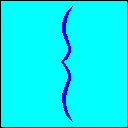 Brackets, otherwise known as braces, group staves
having the same family of instruments or voices. There are two types of brackets commonly
used. One type groups staves having the same family of instruments and the other groups
staves of the same instrumental class. Brackets are found immediately to the left of the
staff system.
Brackets, otherwise known as braces, group staves
having the same family of instruments or voices. There are two types of brackets commonly
used. One type groups staves having the same family of instruments and the other groups
staves of the same instrumental class. Brackets are found immediately to the left of the
staff system.
![]()
Music having several staves must have a means to facilitate reading. A score is a complete composition containing one or several instrumental parts. There may be one or more staves per instrumental part. A part is the portion of a score that the performer plays. When combined with other parts, the music sounds as an ensemble of parts. An ensemble can be any combination of instruments that make up a chorus, band, orchestra, symphony, duets, trios, quartets or any other performance groups.
 Within a score, instrumental parts are grouped in
one of four categories. The instrumental categories are wood winds, brass, percussion and
strings. A square bracket is commonly used for instrumental categories. For ease of
reading, bar lines are usually connected within the staves of an instrumental category, otherwise, the bar line is broken.
Within a score, instrumental parts are grouped in
one of four categories. The instrumental categories are wood winds, brass, percussion and
strings. A square bracket is commonly used for instrumental categories. For ease of
reading, bar lines are usually connected within the staves of an instrumental category, otherwise, the bar line is broken.
 When the instrumental parts are of the same type of
instrument or instrumental family, the staves are grouped with a
bracket called a brace. A brace is like a subdivision of the square bracket. The brace can
be either on its own or placed immediately to the left of a square bracket.
When the instrumental parts are of the same type of
instrument or instrumental family, the staves are grouped with a
bracket called a brace. A brace is like a subdivision of the square bracket. The brace can
be either on its own or placed immediately to the left of a square bracket.
HISTORY
It is difficult to determine the origins of the bracket. Even after Ottaviano de' Petrucci began printing music in 1501, most choral and instrumental music was written as parts. Large instrumental works, such as Claudio Monteverdi's (1567-1643) operas, also had not been printed with brackets. Besides, printing machines where not suited for printing brackets back then. Because of the size of the work, he may have sectioned the staff groupings manually. As printing improved over the years, sectioning staff groupings became easier.
It is also probable that a brace was used for keyboard music sometime after 1600. This would have been necessary to facillitate reading. Evidence in the use of braces appear in the keyboard Sonatas of Arcangelo Corelli (1653-1713). Yet, it is very likely that braces were used in the keyboard works of earlier composers just before 1600.